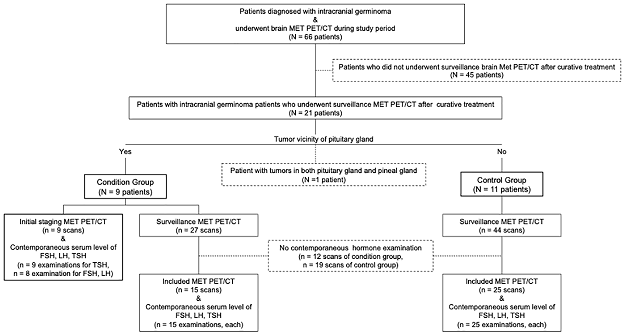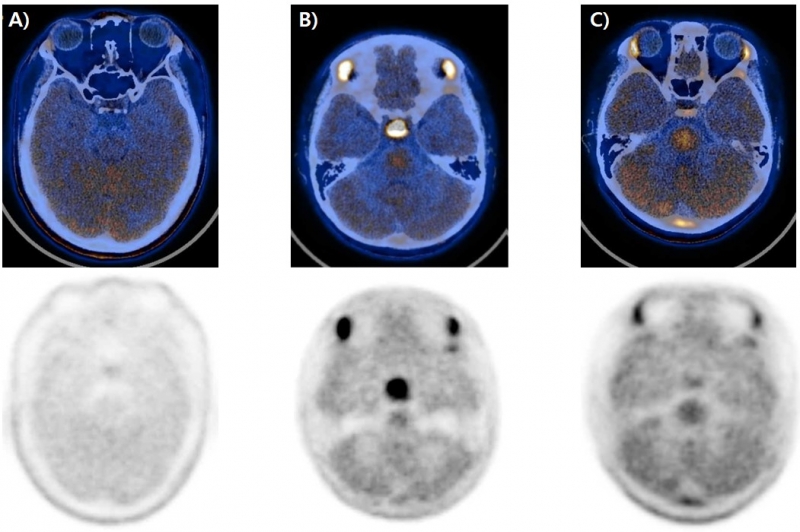글로벌 연구동향
핵의학
- [PLoS One .] Methionine metabolism and endocrine function of the pituitary gland in patients with suprasellar germinoma
성균관의대 / 이환희, 성기웅*, 문승환*
- 출처
- PLoS One .
- 등재일
- 2023 Jul 13
- 저널이슈번호
- 18(7):e0288528.
- 내용
Abstract
Purpose: The aim of this study was to investigate the association between methionine (MET) metabolism and endocrine function of the pituitary gland in patients with suprasellar region tumor.Materials and methods: Twenty patients with intracranial germinoma were included in this study. Initial staging and all surveillance MET PET/CT scans and comparable serum levels of follicle stimulating hormone (FSH), luteinizing hormone (LH), and thyroid stimulating hormone (TSH) were analyzed. The patients were divided into two groups according to tumor location, with tumors in the suprasellar region (condition) or not (control). MET uptake of the pituitary gland (i.e., SUVR [standardized uptake value ratio]) and levels of FSH, LH, TSH were compared in the condition and control groups and in the before and after treatment phases of each group.
Results: The SUVR in the control group was like that found in normal pituitary glands in previous studies, whereas the SUVR of the untreated condition group was high and that of treated condition group was low with significance compared to the control group. Serum levels of pituitary hormones in before and after treatment condition groups were significantly lower than those in the control group. The FSH and LH levels of curatively treated patients in the control group were positively correlated with SUVR with respective ß values of 3.71 and 0.98 (p < .001). The TSH level of the treated condition group was negatively correlated with SUVR (ß = -1.02, p < .001).
Conclusion: This study is the first known investigation to examine the association between MET metabolism and endocrine function of the pituitary gland, and it confirmed that MET metabolism reflects endocrine function. A future study validating the result of correlation analysis is warranted.


Figure 1. Inclusion and exclusion criteria flowchart of the cohort.
Figure 2. Images of methionine PET.
Control (A), suprasellar tumor (B) and post-radiation therapy (C)
Affiliations
Hwanhee Lee 1, Ji Won Lee 2, Hee Won Cho 2, Yearn Seong Choe 1, Kyung-Han Lee 1, Joon Young Choi 1, Ki Woong Sung 2, Seung Hwan Moon 1
1Department of Nuclear Medicine, Samsung Medical Center, Sungkyunkwan University School of Medicine, Seoul, Republic of Korea.
2Department of Pediatrics, Samsung Medical Center, Sungkyunkwan University School of Medicine, Seoul, Republic of Korea.
- 연구소개
- 소아암 환자에서 methionine PET을 이용하여 뇌화수체의 기능과 methionine 섭취와의 연관성을 살펴본 연구입니다. 난포자극호르몬(FSH, 황체형성호르몬(LH), 갑상선자극호르몬(TSH)와 같은 뇌하수체 호르몬들이 SUVR로 측정한 뇌하수체의 methionine 섭취와 유의한 상관관계를 보였으며 methionine 대사와 뇌하수체의 내분비 기능이 연관성이 있음을 의미합니다. 이번 연구는 PET을 이용하여 아미노산 대사와 뇌하수체 내분비 기능 사이의 연관성을 조사한 최초의 연구입니다.
- 덧글달기









